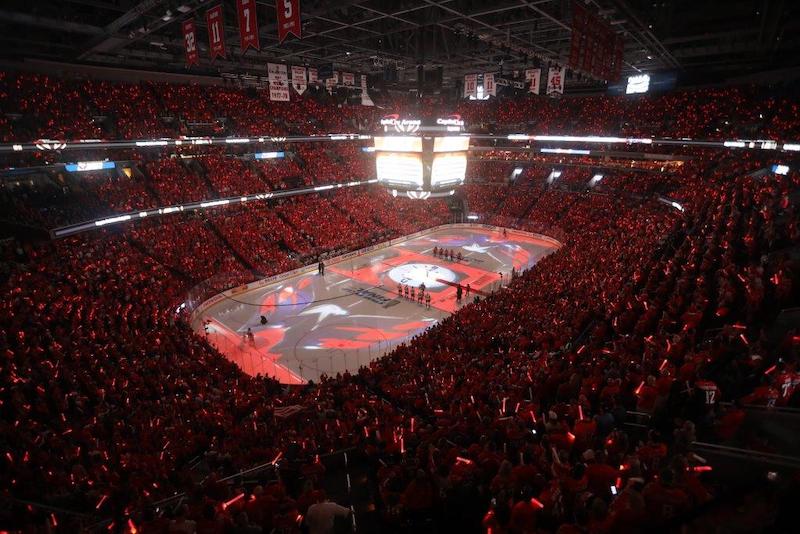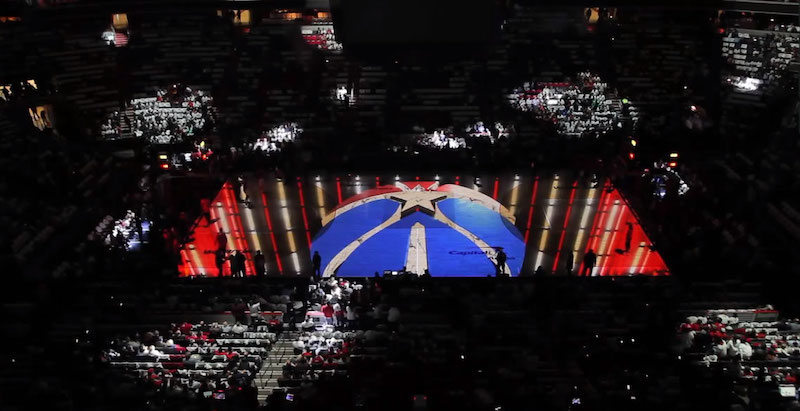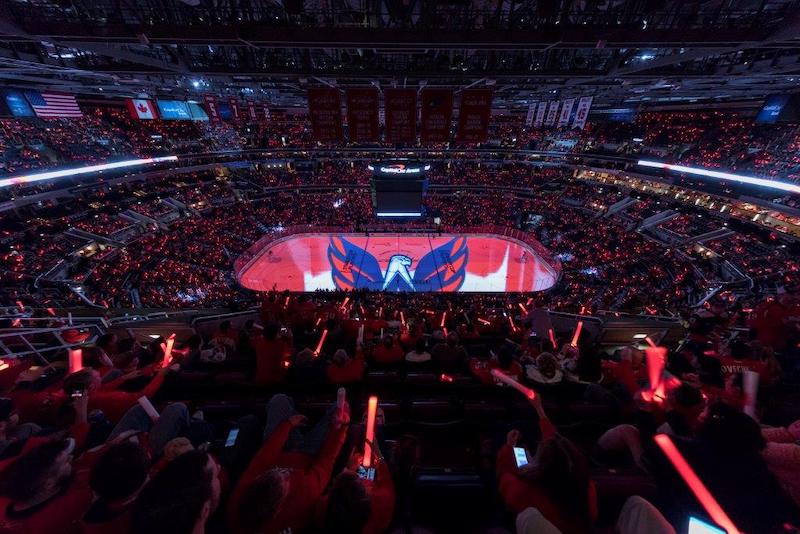Last winter, basketball fans at Oracle Arena, then-home to the Golden State Warriors, were introduced to the PlayStation game God of War. In an elaborate, multimedia promotion, animated content took over the arena’s massive, overhanging score board and ribbon displays. It then transitioned to the basketball court itself, which turned into a snowy dystopia of projected light as the game’s characters battled in front of the sold-out crowd and countless viewers watching online and on TV.
As amazing as it was at the time, this type of projection show — using audiovisual (AV) and digital technologies to transform sports venues into new experiences — has become much more prominent. Venues are effectively using applied video as a design element. For many years, arenas have staged such shows on a temporary basis, but now more are designing the technological capability into their facilities on a permanent basis. What’s known in the AV and production industries as “projection mapping” is becoming as integral to sports venue design as digital signage and public address systems. The video content can be as varied as player profiles and promotion or sponsor marketing and engagement.
“When we do hockey ice or basketball court projection, we try to create fan engagement,” explains Mark Ouwerkerk, Director of Events and Staging for Christie Digital Systems, which makes many of the projectors and supporting technologies used in arenas. “We’re trying to get people more involved in what we’re presenting, because we believe the visual images are what they remember.”

How Projection Mapping Works
Projection mapping is the process of presenting visual content on non-traditional surfaces, such as three-dimensional objects, the outside of buildings, or on basketball courts. At the 2018 Major League Baseball All-Star Game at Nationals Park in Washington, D.C., technologists even projection-mapped the stadium’s infield. At one point, the U.S. Capitol appeared to rise from home plate.
Projection mapping combines powerful projectors, media servers, computer software, and video content to create a unique, immersive show. It’s considered mapping because the specialized software takes the visual content — usually from multiple projectors — and shapes it to fit the target surface, precisely placing (mapping) the video pixels and creating the illusion that the content has been painted virtually onto the court, ice, or infield. The system intelligently combines video streams, and often blends, warps, or otherwise manipulates the video into a uniform, digital canvas. For example, in the case of projection mapping onto an ice rink, the video perfectly fits the surface’s rounded corners and light does not spill into the seats.
“The more complex,” says Ouwerkerk, “the more technology required.” In existing arenas, he says, the positioning of elements like scoreboards and other permanent fixtures can determine where projectors must be placed and how much processing will be applied to the content to compensate for odd angles and ensure the video looks perfect.
Design Considerations
Quince Imaging, projection-mapping specialists based in Sterling, Virginia, executed the Oracle Arena and Nationals Park productions and have worked in professional and college sports venues throughout the United States. Scott Williams, Quince Imaging’s co-founder and chief operating officer says that by now, virtually every major arena has staged a projection-mapping production, but less than one-quarter have built the capability into the venue’s infrastructure as a permanent feature. Doing so takes planning and coordination among design, construction, and technology teams.
“For existing arenas, we do an engineering analysis and study and get our technical plan approved to ensure the structure can hold the system the way we intend to install it,” Williams says. “More recently, for new venues, we’ve been working with construction firms like Samet Corp. and Turner Construction at the very beginning, when it’s still in the design phase, to integrate the desired projection-mapping system in the early stages. That way we can plan for power, signal, structure, weight, and methodology, and it works very smoothly.”
Installed projection-mapping systems are usually purpose-built — specified and installed to support the intended content and experience, but not usually repurposed or reconfigured for other uses. When incorporated into a venue’s design, today’s projection-mapping systems are often treated as lighting. The same way a lighting designer creates a plot to evenly illuminate the venue, AV integrators ensure a sufficient number of projectors, installed in the right locations, will bathe the target surface in video light.

Systems Vary in Size
In sports arenas, a typical projection-mapping installation can include eight to 12 large projectors and cost $750,000 to $1 million or more, which more teams and venues see as a sound investment toward creating an exceptional live experience. Quince Imaging recently installed 18 projectors at PNC Arena in Raleigh, North Carolina, home to the NHL’s Carolina Hurricanes and college’s N.C. State Wolfpack. “They wanted the best system, designed to be the brightest, highest-resolution system in sports,” Williams says. “And it is.”
The size and scope of a projection-mapping system depends on the content the venue intends to project and characteristics of the venue itself. For example, professional sports arenas often require more projectors than college sports arenas because they must overcome ambient light from other digital signage, which teams may be contractually required to keep illuminated even when a projection show is taking place. And because ice rinks are larger than basketball courts, they typically require more projection.
Quince Imaging worked with Monumental Sports & Entertainment on Capital One Arena, which supports Washington, D.C. hockey and basketball teams. The turnkey system, which consisted of 12 high-brightness 4K-resolution projectors, maps 2D and 3D content onto the ice for the Capitals and onto the court for the Wizards, adjusting to the different size of each surface.
Mapping Exterior Surfaces
And that’s just the inside of sports venues. The next frontier will be projection mapping on the exterior of arenas and stadia. For example, Little Caesars Arena in Detroit was designed with a curved, metal-canvas “skin” on 600 feet of its outer wall. Venue operators use 12 projectors to “paint” it with digital branding, advertising, and feeds from events inside the arena. In London, AV technologists turned the roof of the O2 Arena into an enormous projection surface (16,000 square meters) with a staggering 68 projectors putting out 1.4 million lumens of light.
“Projecting on arena facades takes an installed system, too, and can be thought of like lighting or digital signage,” says Quince Imaging’s Williams. “When the venue is hosting 200 different events a year it creates an engaging experience for visitors.”
As AV technology evolves, designers can expect projection mapping solutions to be more colorful, vibrant, lifelike, and interactive. Eventually, with tracking technology, fans will be able to play games on the ice or court. “Real-time fan engagement is the next great trend in this industry,” says Williams. “We’re in territory now where we’ve never been before.”
Related Stories
| Nov 3, 2010
Park’s green education center a lesson in sustainability
The new Cantigny Outdoor Education Center, located within the 500-acre Cantigny Park in Wheaton, Ill., earned LEED Silver. Designed by DLA Architects, the 3,100-sf multipurpose center will serve patrons of the park’s golf courses, museums, and display garden, one of the largest such gardens in the Midwest.
| Nov 3, 2010
Sailing center sets course for energy efficiency, sustainability
The Milwaukee (Wis.) Community Sailing Center’s new facility on Lake Michigan counts a geothermal heating and cooling system among its sustainable features. The facility was designed for the nonprofit instructional sailing organization with energy efficiency and low operating costs in mind.
| Nov 3, 2010
Recreation center targets student health, earns LEED Platinum
Not only is the student recreation center at the University of Arizona, Tucson, the hub of student life but its new 54,000-sf addition is also super-green, having recently attained LEED Platinum certification.
| Oct 13, 2010
New health center to focus on education and awareness
Construction is getting pumped up at the new Anschutz Health and Wellness Center at the University of Colorado, Denver. The four-story, 94,000-sf building will focus on healthy lifestyles and disease prevention.
| Oct 13, 2010
Community center under way in NYC seeks LEED Platinum
A curving, 550-foot-long glass arcade dubbed the “Wall of Light” is the standout architectural and sustainable feature of the Battery Park City Community Center, a 60,000-sf complex located in a two-tower residential Lower Manhattan complex. Hanrahan Meyers Architects designed the glass arcade to act as a passive energy system, bringing natural light into all interior spaces.
| Oct 13, 2010
Community college plans new campus building
Construction is moving along on Hudson County Community College’s North Hudson Campus Center in Union City, N.J. The seven-story, 92,000-sf building will be the first higher education facility in the city.
| Oct 12, 2010
Owen Hall, Michigan State University, East Lansing, Mich.
27th Annual Reconstruction Awards—Silver Award. Officials at Michigan State University’s East Lansing Campus were concerned that Owen Hall, a mid-20th-century residence facility, was no longer attracting much interest from its target audience, graduate and international students.
| Oct 12, 2010
Building 13 Naval Station, Great Lakes, Ill.
27th Annual Reconstruction Awards—Gold Award. Designed by Chicago architect Jarvis Hunt and constructed in 1903, Building 13 is one of 39 structures within the Great Lakes Historic District at Naval Station Great Lakes, Ill.
| Sep 16, 2010
Green recreation/wellness center targets physical, environmental health
The 151,000-sf recreation and wellness center at California State University’s Sacramento campus, called the WELL (for “wellness, education, leisure, lifestyle”), has a fitness center, café, indoor track, gymnasium, racquetball courts, educational and counseling space, the largest rock climbing wall in the CSU system.
| Sep 13, 2010
Stadium Scores Big with Cowboys' Fans
Jerry Jones, controversial billionaire owner of the Dallas Cowboys, wanted the team's new stadium in Arlington, Texas, to really amp up the fan experience. The organization spent $1.2 billion building a massive three-million-sf arena that seats 80,000 (with room for another 20,000) and has more than 300 private suites, some at field level-a first for an NFL stadium.

















